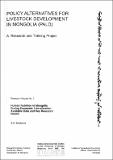| dc.description.abstract | Over the past two years, Mongolia has been attempting to move from a
largely Soviet-inspired command economy to one which is led by market
forces. Privatisation of the livestock, although not the grazing lands, of
pastoralist collective farms has been proceeding to various degrees in
different areas. This has taken place in a context in which, since the
ending of Soviet subsidies to satellite Asian republics in early 1991,
international trade in foodstuffs has been disrupted.
The consequences of this economic liberalisation for the nature of food
supplies have differed between states. Meat, milk, fruit and vegetables
have been hard to obtain in Kazakhstan, Kirghizstan, Tajikistan,
Turkmenistan and Uzbekistan (the Central Asian Republics - CAR states),
where consumption of bread and potatoes has risen sharply to compensate for
shortages of these items (Chen et al. 1992) . These changes broadly resemble
those which have affected some Eastern European states since the late
1980s, notably Poland (Szostak and Sekula 1991) but also some other
countries (Traill and Henson 1991). By contrast, in Mongolia the large
livestock sector has permitted increasing dependence on meat and milk, to
compensate for reductions in the absolute availability of flour and
vegetable foods. In both regions, there has therefore been concern over the
food security of groups vulnerable to poor health and nutrition. Baseline
information is central to understanding the nutritional correlates of
economic change in this case; and this paper therefore reviews available
data concerning nutrition in Mongolia with the aim of identifying specific
lines of inquiry for future nutritional research. | en_GB |

